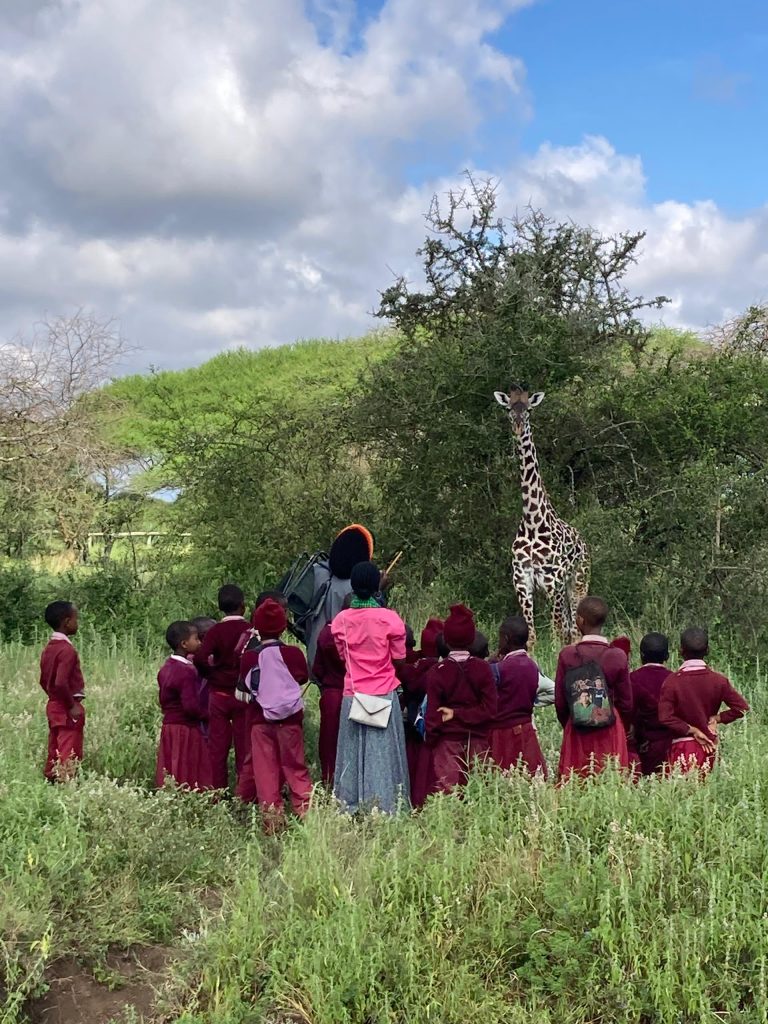The Education Centre

A Space for Discovery and Action
Nestled in the heart of our re-wilded farm, the Arusha Giraffe Centre’s Education Hub is dedicated to “Regenerating Our Landscapes.” This space invites visitors to dive into the complex yet fascinating relationships between Community, Environment, and Wildlife. Through interactive displays and hands-on demonstrations, guests can see firsthand how the delicate balance of nature can be restored and maintained.
The Centre’s four sections each tell a different story: the first focuses on the critical role of community in conservation, the second brings to light the environmental challenges faced by wildlife, and the third highlights the importance of biodiversity for a healthy ecosystem. The fourth section, Eco-Agriculture, offers practical, real-world solutions for reversing land degradation and building sustainable livelihoods. The Education Centre serves as both a learning space and a call to action, inspiring guests to become part of the solution for a more sustainable future.
“Change comes through education, and we want to teach children first.”
School children, many seeing a giraffe for the first time, learn about the threats facing Tanzania’s national animal and the simple, sustainable solutions that can protect both wildlife and livelihoods. Nick envisions an ambitious goal: to have every child in Tanzania visit the Arusha Giraffe Centre. The program provides local school children with transportation to the facility, meals, and invaluable hands-on learning experiences. Students not only get the rare opportunity to observe giraffes up close but also learn about regenerative farming techniques that can restore degraded landscapes.
Beyond school visits, we run quarterly workshops for local farmers, sharing techniques that reverse land degradation and support long-term prosperity. Every visitor leaves with a deeper understanding of conservation and an opportunity to take action.


Beyond Learning
Designed to blend seamlessly with nature, the centre features locally sourced materials, an airy thatched roof, and a biogas generator that transforms organic waste into energy for boiling water. Inside, the naturally cool space is filled with light, while outside, guests can relax under the shade of a magnificent Acacia tree.
Beyond learning, the centre also offers a carefully curated selection of locally made souvenirs, handcrafted by talented artisans from the community. Visitors can also enjoy seasonal, home-style meals, made with fresh, locally grown ingredients, including hearty dishes, crisp salads, and delicious sandwiches.
Whether you’re here to learn, connect, or simply enjoy the surroundings, the Education Centre is a place where knowledge meets action. Education is the key to lasting change, and at the Arusha Giraffe Centre, learning is an adventure.
Our Impact
At the Arusha Giraffe Centre, we are committed to making a lasting difference for both giraffes and local communities. In line with the National Giraffe Conservation Action Plan, we focus on two key areas:
- Raising Awareness: Educating visitors, schoolchildren and farmers about the giraffe conservation status in Tanzania.
- Reducing Threats: Restoring degraded landscapes, promoting sustainable farming and creating economic opportunities that support both people and wildlife.
Through education, conservation, and community engagement, we are working towards a future where giraffes thrive and communities benefit from living alongside them.
School children we have hosted at the Arusha Giraffe Centre to date
Target number of school children hosted by 2035
Target number of guests hosted at the Arusha Giraffe Centre per year
Target number of acres to regenerate by 2035
The Silent Extinction
Giraffes are undergoing a “silent extinction,” with their population declining by nearly 30% over the past 35 years. Today, fewer than 117,000 giraffes remain in the wild, compared to over 155,000 in 1985. Once widespread across Africa, they have already gone extinct in seven countries. The Maasai giraffe is listed as ‘Endangered’ on the IUCN Red List. Habitat loss due to agricultural expansion, deforestation, and infrastructure development is the biggest threat, shrinking their range by almost 90% over the last 300 years. Poaching for bushmeat and traditional medicine, as well as human-wildlife conflict, also contribute to their decline.
Despite these alarming trends, giraffes receive significantly less conservation attention than other large African mammals like elephants and rhinos. Urgent action is needed to protect their habitat, enforce anti-poaching laws, and establish breeding programs to ensure their survival for future generations. Conservation efforts, including habitat protection and anti-poaching measures, are crucial to reversing this trend.
Worldwide elephant population
Increase in poaching between 2020 and 2022
Estimated remaining giraffes on the planet
Estimated remaining Giraffe in Tanzania
